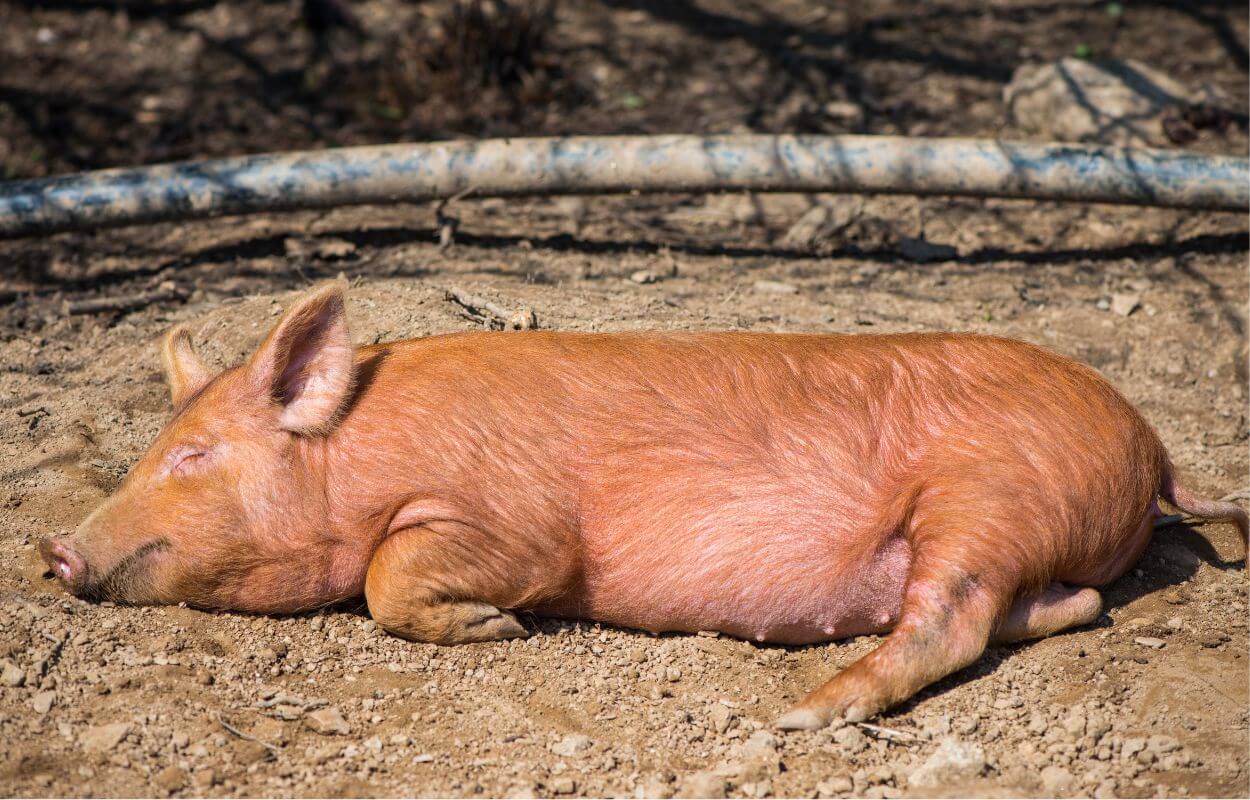
Tamworth pigs are a great choice for homesteaders who want a flexible and satisfying breed. These tough animals, known as Tamworths, have good characteristics, great temperament, and behavior that make them a perfect choice.
So, thinking about raising Tamworth pigs on your farm?
I’m here to help you decide more easily if this pig breed is right for you by providing detailed information about their traits, growth rate, advantages, and disadvantages of Tamworth pigs, and more.
Good to know: If you’re a bacon lover, you’ll be pleased to know that this pig breed has a long body, which means more bacon for you. That’s why it’s also called the “bacon pig.”
Contents
History and Origins
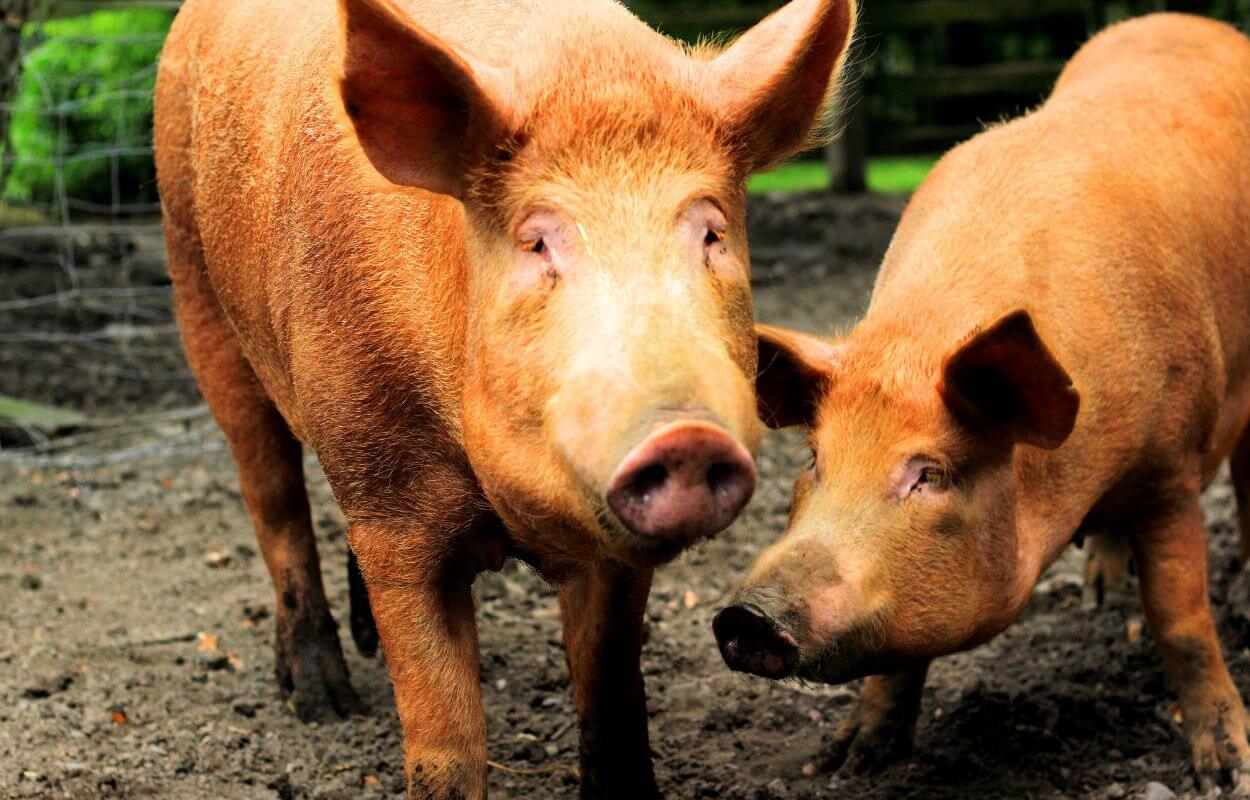
The Tamworth pig’s origin is unknown, but it is surrounded by different stories and suspicions about how it originated and why it has an unusual color.
One theory suggests that the Tamworth pig descended from Irish pigs, also known as Irish Grazers. It is believed that Sir Robert Peel brought them to his estate in Tamworth, England, and crossed them with other local pigs. According to this story, Tamworth pigs are from Tamworth, Staffordshire England.
Other stories related to the pig’s color claim that the Tamworth pig originated from a West African Guinea Hog from Portugal or a pig imported from Barbados in 1750.
The breed was officially recognized in 1865 and established its first Tamworth Incorporated Pig Breeders Association in 1906. Tamworth pigs were imported to the United States in 1882, followed by Canada and Australia.
Currently, the Tamworth pig is listed as threatened in the United States and vulnerable in the United Kingdom.
What is a Tamworth pig?
Tamworth pig is a domestic pig breed that is also considered one of the world’s oldest and rarest pig breeds.
Conservation programs are actively working to preserve and promote the breed’s genetic diversity and unique characteristics.
Pig Characteristics
The Tamworth pig’s characteristics are highly distinctive, making them a breed unlike any other.
Here are the important traits of Tamworth pigs that set them apart:
Color
The Tamworth pig’s color is a unique reddish-brown or ginger, but the exact shade can vary from a light golden-red to a darker reddish one. The pig’s red coat color distinguishes it from other pig breeds, making it truly unique in appearance.
Hair
The Tamworth pig has a straight and dense coat of hair in a reddish color. This reddish hair provides protection against sun rays and rain.
Size
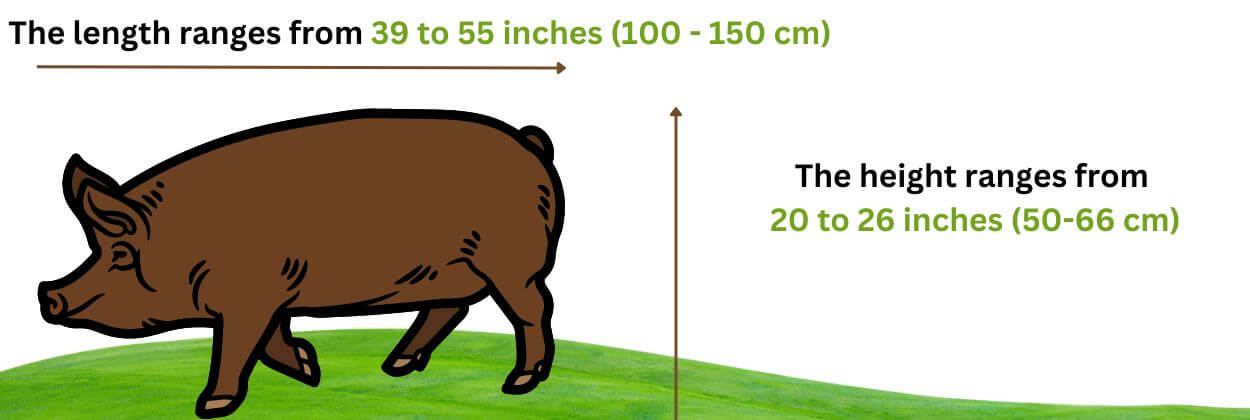
The Tamworth pig’s size is medium to large. A Tamworth pig can have a height ranging from 20 to 26 inches (50-66 cm) and a length of 39 to 55 inches (100-150 cm).
Body
The body of the Tamworth pig is long and highly muscular, with a wide and deep chest.
Head
The head of the Tamworth pig is proportionate to the rest of the body. It is long and features a rectangular shape with a flat forehead, a well-defined jawline, and two small eyes set apart on the sides of the head. The snout is long and slightly upturned.
Ears
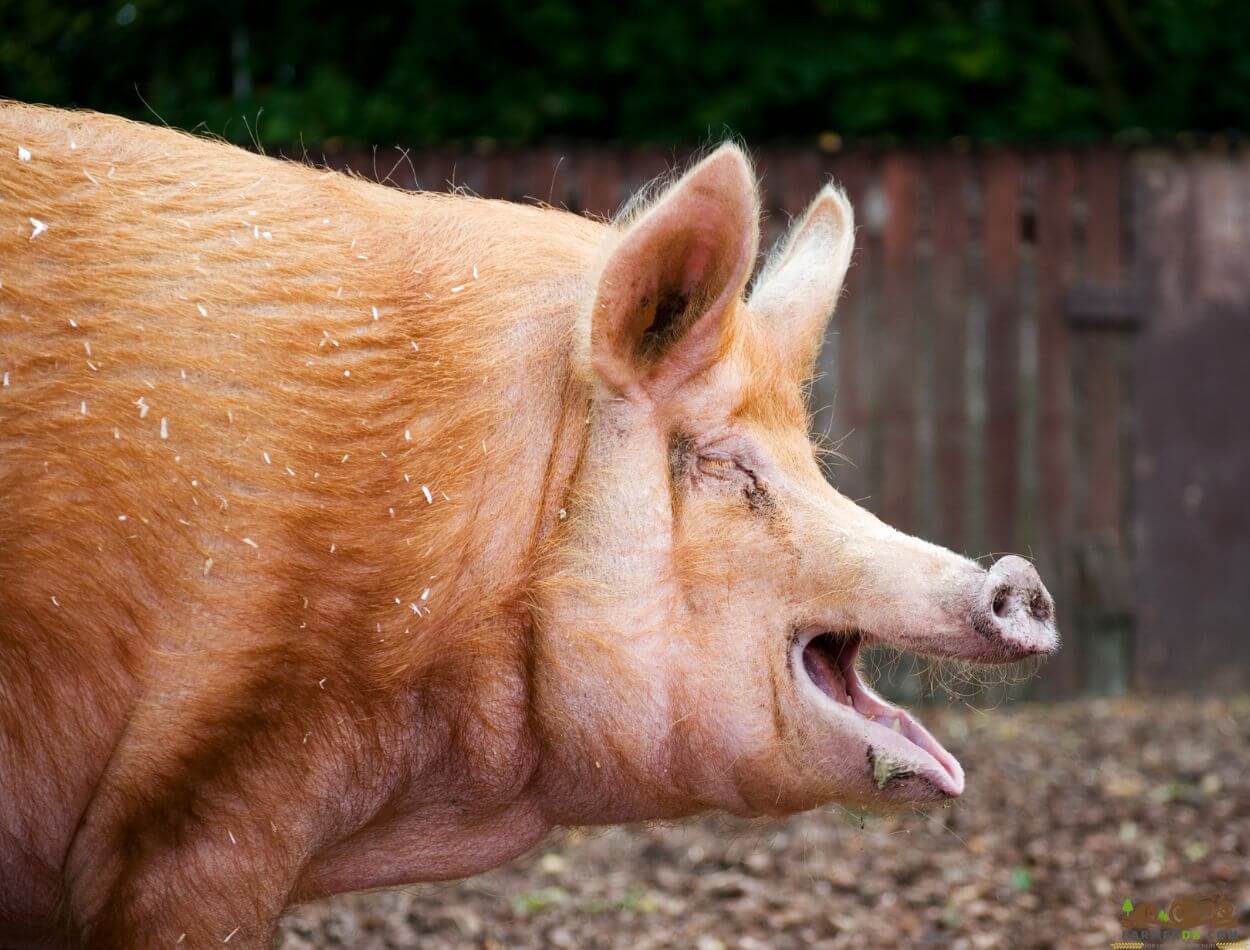
The ears of the Tamworth pig are of medium size, erect, and always facing forward. Like the rest of the body, the ears are covered in hair and have a reddish color matching the pig’s skin.
Unlike breeds such as the Mangalica pig, which has droopy ears, the Tamworth pig’s ears remain erect to ensure constant receptiveness to its surroundings.
Did you know: The Tamworth pigs’ ears have been used in a unique ear notching system since 1967 to help farmers keep track of their Tamworth pigs, monitoring their health and breeding programs. The Tamworth Ear Notching system is a method of identifying individual pigs and involves making distinct notches or cuts in the pigs’ ears.
The right ear represents the litter number, which will be identical for all pigs from a litter, while the left ear represents the pig’s specific number, which will be different for each pig.
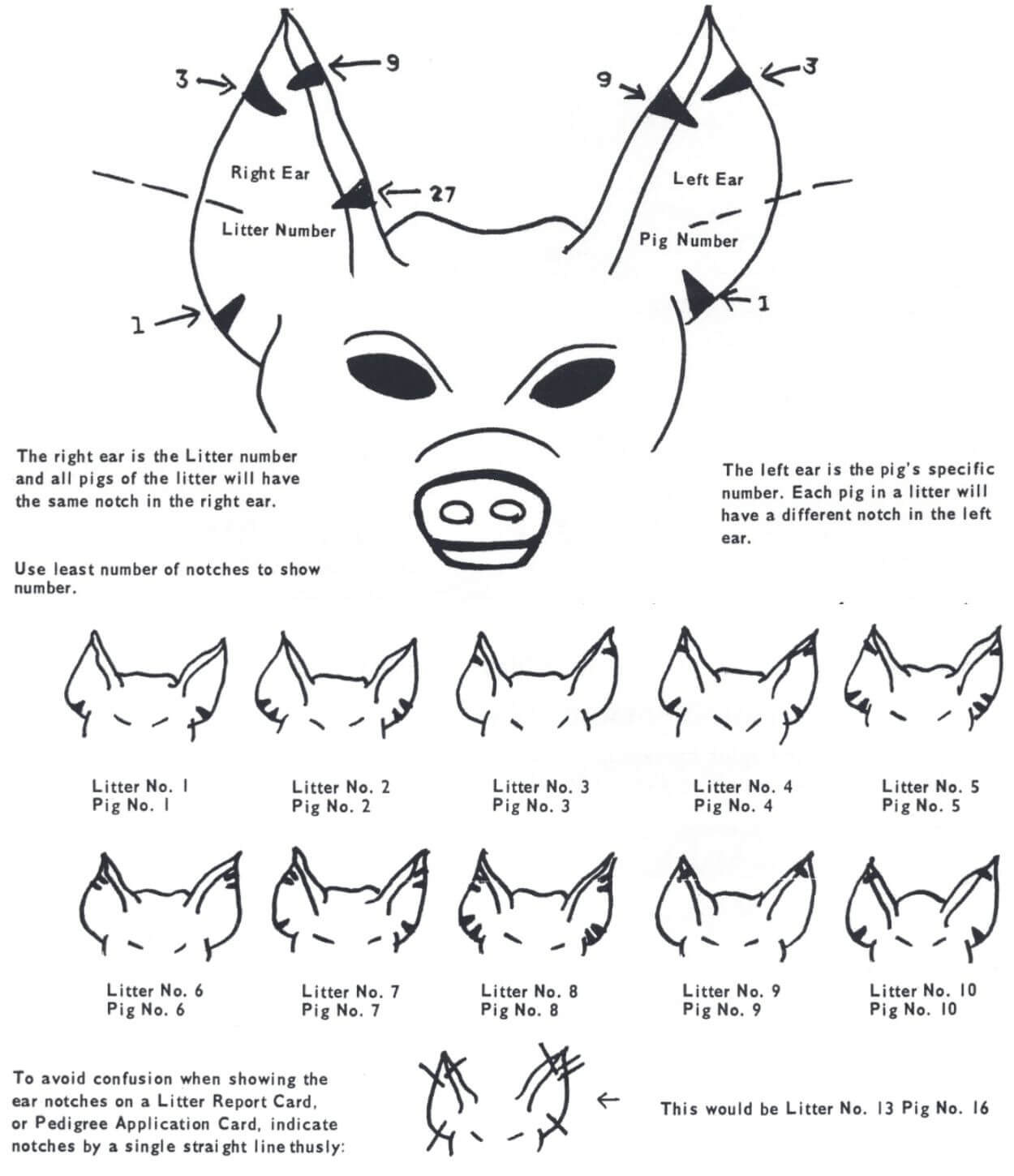
Legs
Compared to their muscular bodies, the legs of Tamworth pigs are relatively short but remarkably sturdy, efficiently supporting their overall weight.
Tamworth pigs have excellent mobility, and their hooves are hard and durable, contributing to their ability to move with ease and stability.
Tail
The tail of the adult Tamworth pig is straight, although they also have the ability to curl it. The length of the curled tail of a Tamworth pig can reach up to 12 inches.
Lifespan
The lifespan of a Tamworth pig ranges from 15 to up to 20 years, which is quite long compared to other breeds such as Gloucestershire Old Spots or Chester White.
Growth Rate
How fast do Tamworth pigs grow?
The growth rate of Tamworth pigs is considered moderate and can depend on factors such as nutrition, environment, and genetics.
It is important to know that Tamworth pigs reach maturity at around two years of age, which is relatively later compared to some other pig breeds.
Weight
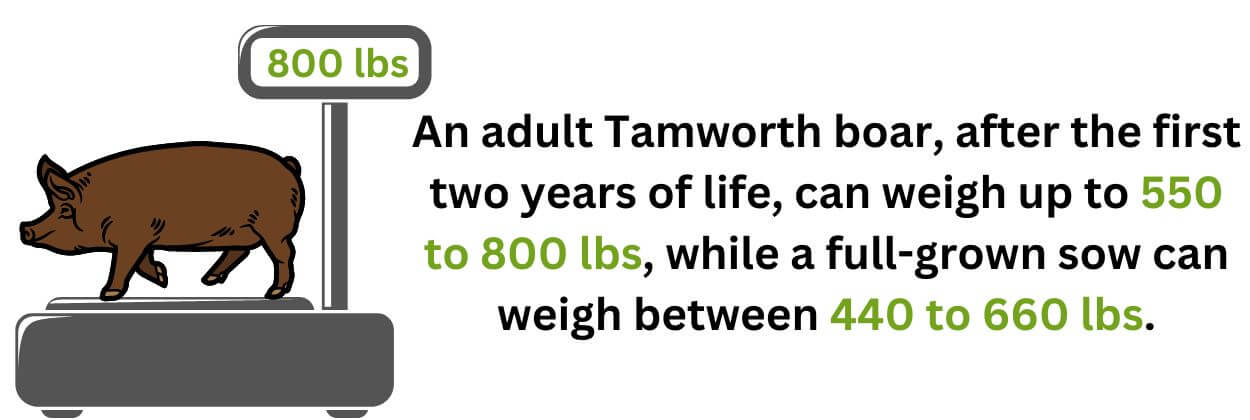
The Tamworth pig’s weight can range between 150 and 220 lbs at 5 to 6 months of age and 225 to 300 lbs at 7 to 8 months of age.
An adult Tamworth boar, after the first two years of life, can weigh up to 550 to 800 lbs, while a full-grown sow can weigh between 440 to 660 lbs.
At birth, Tamworth piglets typically weigh around 2 to 3 lbs, but they reach a weaning weight of 20 to 30 lbs in the following weeks.
The average weight gain of a Tamworth pig during its growing phase is typically around 1 to 1.5 lbs per day. This weight gain can vary during different stages of the pig’s development.
Generally, higher rates of weight gain are observed in the early stages, while growth may slow down slightly as the pigs mature.
Slaughter weight and time
The slaughter weight of a Tamworth pig typically ranges from 150 to 220 lbs, which the pig reaches within the first 5 to 6 months of life.
It is also acceptable to slaughter a Tamworth pig at 7 to 8 months of age with a weight of over 230 lbs.
The ideal slaughter time for a Tamworth pig is typically around 5-6 months of age.
But how much meat do you get from a Tamworth pig? You can get approximately 105 to 130 lbs of carcass weight from a Tamworth pig of 150 to 220 lbs, which represents a meat yield of around 70%.
Temperament and Behaviour
Tamworth pigs have great temperament and behavior. These pigs are calm, docile, gentle, friendly, and extremely playful.
Tamworth pigs are very friendly and approachable, and their docile nature makes them well-suited for all types of farmers.
They can also live well with other animals on the farm. Tamworth pigs are social animals and can live happily within herds. Within their own herd, they are capable of developing strong bonds with other Tamworth pigs, often engaging in grooming and playful interactions.
In terms of intelligence, Tamworth pigs are quick to learn about their environment and its boundaries. While they can be trained to respond to commands, training them may be more challenging compared to miniature pigs like Vietnamese Potbelly pigs, as Tamworth pigs have higher energy levels.
Speaking of energy, they love to explore and sometimes lead farmers on funny chases as they enjoy adventure, action, and being playful.
Tamworth pigs have a strong foraging instinct and take pleasure in rooting in the ground to find food. This behavior is deeply ingrained in their nature, allowing them to utilize their excellent sense of smell to search for edible plants, roots, and insects.
Regarding Tamworth sows, they possess good maternal instincts and nurture their piglets very well. While they are protective, they are not aggressive if you attempt to interact with their piglets. They stay close to their piglets and behave gently, unlike some other pig breeds that may accidentally sit on their piglets when resting.
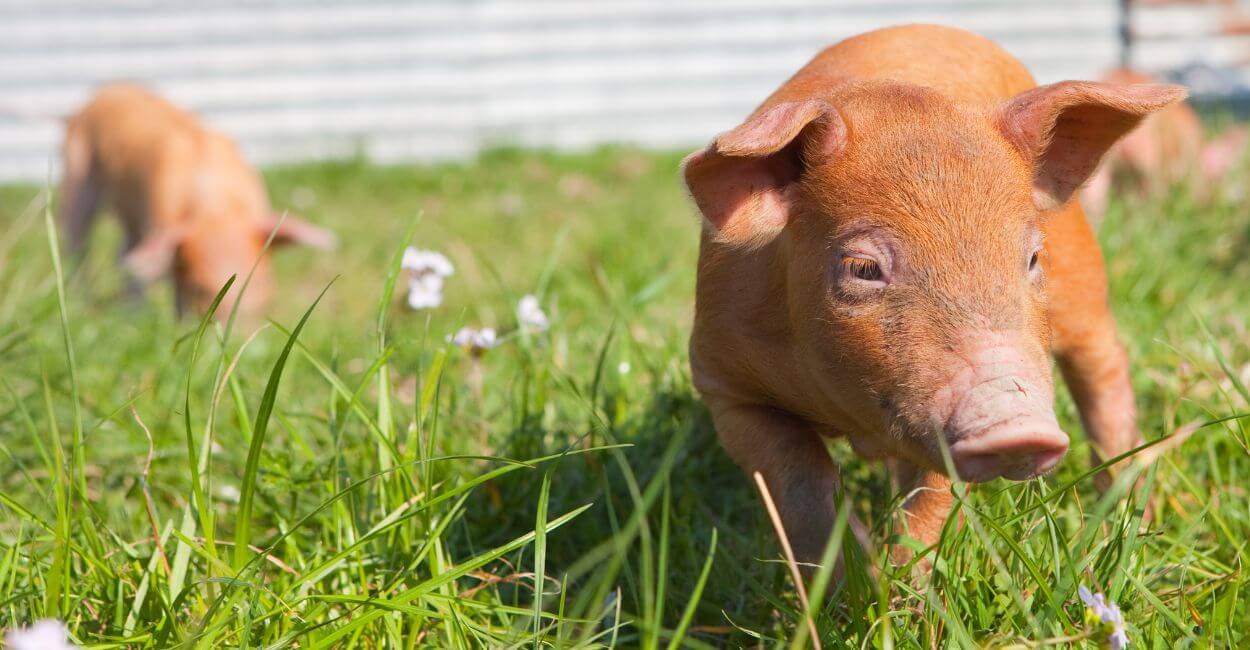
And, of course, the sows begin teaching the Tamworth piglets to be playful and adventurous from a young age, encouraging them to explore and engage in fun and playful behaviors.
Tamworth pig meat
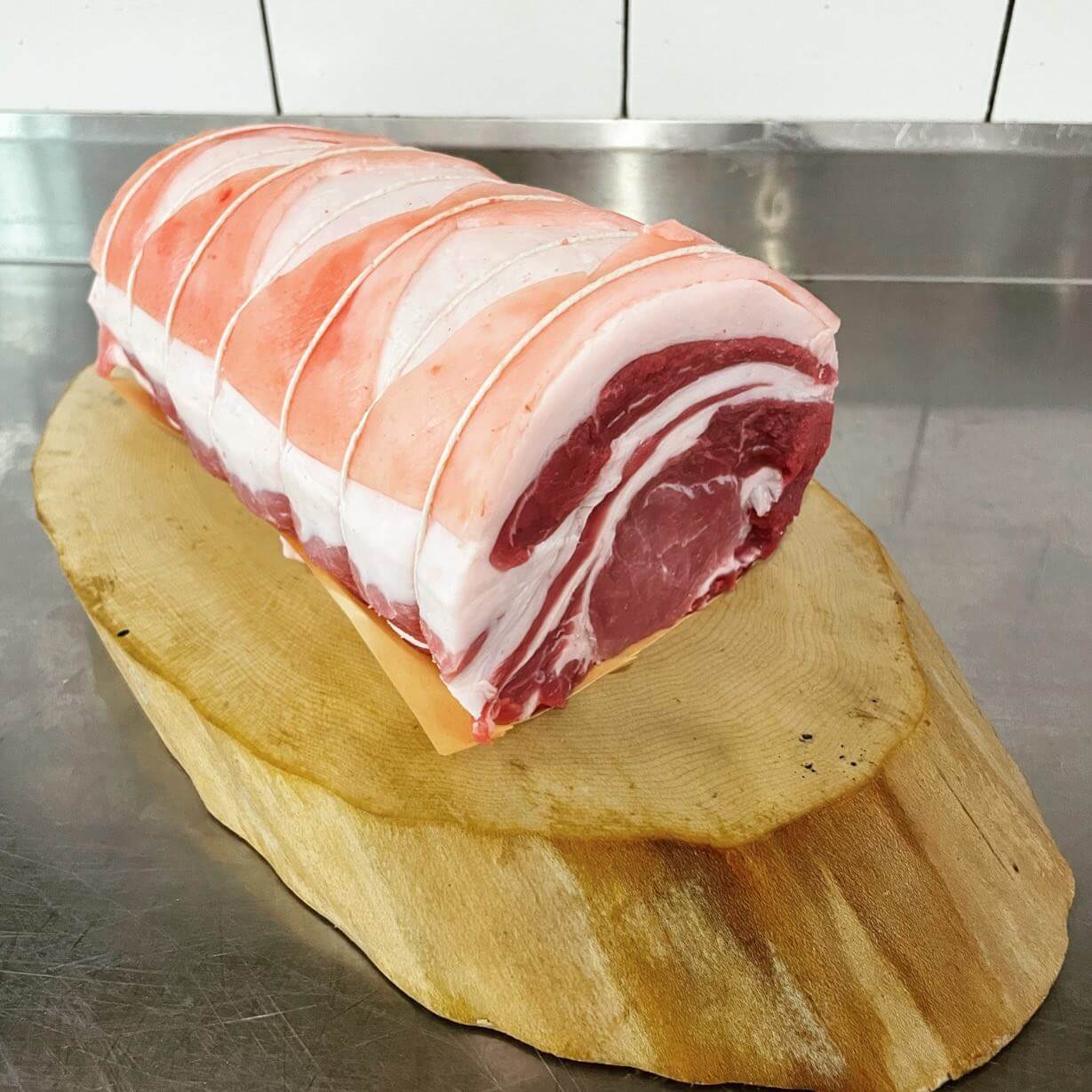
Tamworth pigs are known for their lean meat with the right amount of fat, earning them the reputation of being the bacon pig breed.
The Tamworth pigs’ meat quality is highly appreciated as it contains a significant proportion of lean meat along with well-distributed intramuscular fat, resulting in a tender, juicy texture.
The meat has a good level of firmness and is not overly soft or chewy when cooked. Popular cooking methods for Tamworth meat include grilling, roasting, and braising.
Moreover, Tamworth pig meat is known for its flavor, tenderness, and marbling. The marbling contributes to the meat’s moisture and gives it a nutty taste. The Tamworth pig meat taste is influenced by the pigs’ rooting, grazing activities, and overall nutrition.
Tamworth pig meat is used in various culinary applications. While it is commonly utilized for bacon production, it is also used for sausages and charcuterie products.
Overall, the meat of Tamworth pigs offers a combination of leanness, tenderness, and rich flavor, and is rich in omega-3 amino acids and linoleic acid that help lower cholesterol.
Raising Tamworth Pig
Raising Tamworth pigs is an easy activity for homesteaders who do not want to spend a lot of time caring for them. These pigs are known for their low-maintenance nature and independence.
Feeding
You can feed Tamworth pigs with wild blackberries, fresh fruits, vegetables, eggs, dairy products such as milk, meat, ground grain or standard pellets, alfalfa, clover, and grass hay. In addition to these, the Tamworth pig’s diet can also include acorns and kitchen scraps as long as they do not contain excessive salt, sugar, or mold.
The Tamworth pigs have also the natural ability to forage if they are raised in a pasture-based system. They will root and graze on their own, searching for grubs, worms, insects, and beetles. During hotter seasons, they are more active in grazing and rooting early in the morning, while in winter, they tend to rest more, conserving their calories.
While they can graze, it is important to supplement their diet with additional feed to ensure they receive the necessary minerals, vitamins, and protein for healthy growth.
Environment
The ideal environment for Tamworth pigs is one that provides ample space for them to run, explore, graze, and root. Tamworth pigs thrive when raised in an outdoor environment.
They are not adaptable to living in indoor or confined systems like other pig breeds. Due to their high energy levels, they require free access to outdoor areas to fulfill their natural behaviors and consume the necessary energy.
The outdoor living space should always be secured with an electric fence to prevent Tamworth pigs from escaping or being attacked by other wild animals.
Climate
Tamworth pigs are ideally raised in temperate or mild climates where they thrive without significant concerns.
They can also adapt to colder or hotter climates with proper care and suitable conditions.
In colder climates, providing sturdy shelter and bedding is essential to maintain their health and well-being. In hotter climates, in addition to shelter, they require access to a reliable water source, a wallow for cooling, and ample shade to protect them from the heat.
Shelter
Tamworth pigs require shelter even in mild climates to protect them from harsh weather conditions such as intense sun in summer, rain, storms, and winds. They do not require a special shelter, a simple pig shelter or a barn is sufficient to meet their needs.
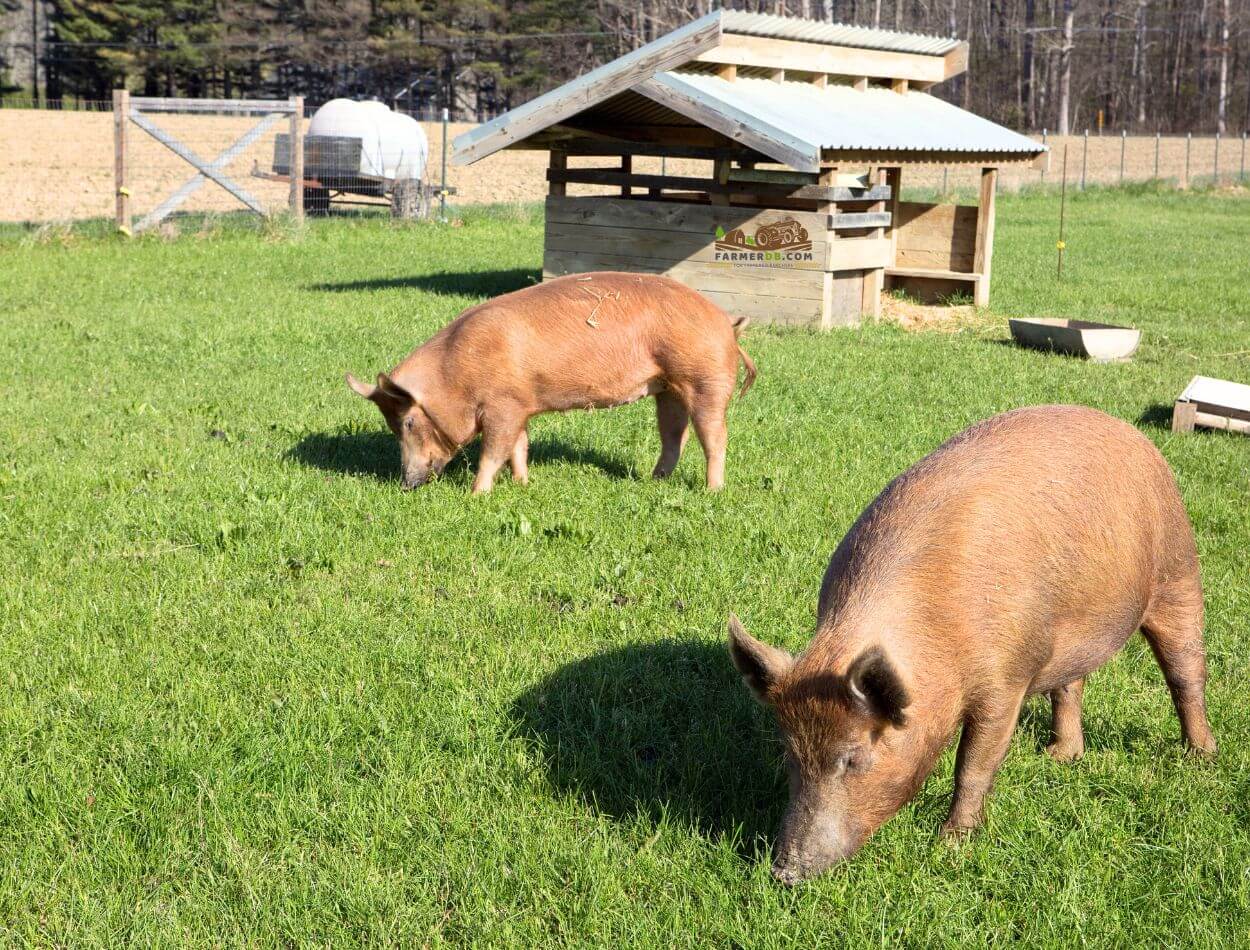

How many Tamworth pigs per acre?
You can raise 6 to 8 Tamworth pigs per acre, depending on the level of vegetation available on the land.
If the vegetation is not abundant, you may need to remove some pigs to maintain optimal grazing conditions and prevent overgrazing.
Breeding
The Tamworth breeding process can be done naturally by mating a sow with a boar. A Tamworth sow reaches sexual maturity at around 8 months of age, and a boar at 8 to 9 months. So, you can start breeding them at around that age, but you can also wait until 10 months.
Tamworth pigs can be bred throughout the year, as long as the sow is in heat and both the boar and sow are of the appropriate age. The gestation period for a Tamworth sow is 114 days, or 3 months, 3 weeks, and 3 days.
The average litter size for Tamworth pigs is 6 to 10 piglets, which is relatively good.
The farrowing process typically does not require a lot of support, as the sow can usually give birth without assistance. Tamworth sows have great mothering skills and produce an ample amount of milk to feed all the Tamworth piglets.
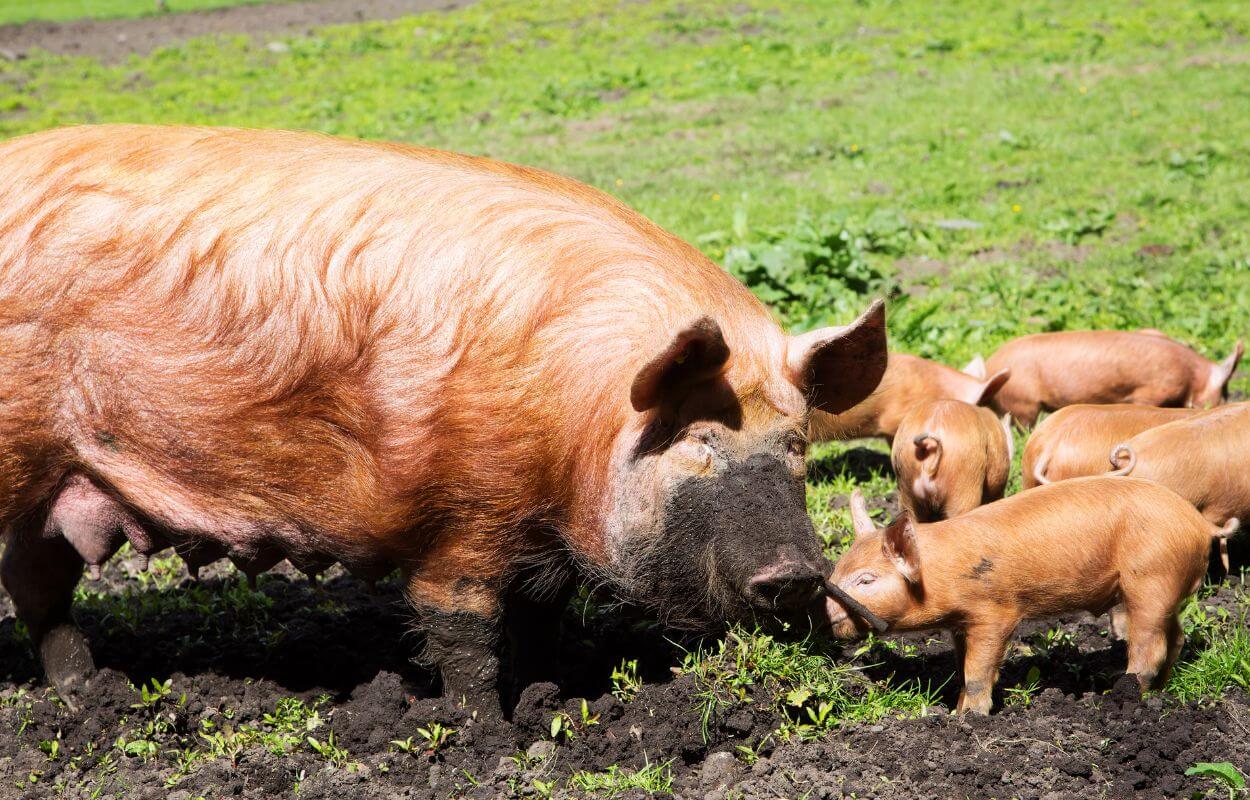
The piglets of the Tamworth pig breed have one of the highest survival rates among pig breeds.
This is a testament to the breed’s resilience and strong maternal instincts, as Tamworth sows excel in nurturing and caring for their offspring.
Artificial insemination is also possible for breeding Tamworth pigs. This involves collecting semen from a selected boar and artificially inseminating the sow.
Overall, the breeding of Tamworth pigs can be done naturally or through artificial insemination, depending on the specific circumstances and preferences of the breeder.
Health issues
The common health issues that can affect Tamworth pigs include external parasites such as lice and mange mites, which can cause skin problems and discomfort.
In addition, diseases like swine influenza and porcine reproductive and respiratory syndrome (PRRS) can be a risk to Tamworth pigs. Following a proper pig vaccination schedule and practicing good biosecurity measures can help prevent these diseases and maintain the overall health of the pigs.
Why should you raise it?
If your intention is to grow Tamworth pigs for the purpose of generating profit, then you should know that raising Tamworth pigs does not offer financial returns.
Tamworth pigs are not commonly raised on a large scale due to their specific requirements. They are not well-suited for indoor or confined spaces and thrive when provided with ample outdoor space for healthy growth.
Tamworth pigs are a good choice for homesteads. Whether you are a beginner or an experienced homesteader, managing Tamworth pigs is relatively easy, and they can provide a substantial amount of high-quality meat. With a 70% yield of meat, including lean cuts and well-marbled portions, they can provide meat for an entire family.
Furthermore, Tamworth pigs can contribute to the maintenance and fertilization of pastures, making them a valuable asset in sustainable farming practices.
Do not forget that by raising Tamworth pigs you help to preserve and promote this rare breed.
Advantages and Disadvantages
Growing the Tamworth pig breed comes with several advantages and disadvantages. Below, you will find a list of the benefits and drawbacks associated with Tamworth pigs.
| Advantages of Tamworth pigs | Disadvantages of Tamworth pigs |
|---|---|
| They exhibit adaptability to a wide range of climates. | They require an outdoor environment and are not suitable for indoor or confined spaces. |
| They possess a strong foraging instinct and are skilled at rooting and grazing. | Finding and purchasing Tamworth pigs can be challenging due to their limited availability. |
| They yield high-quality meat with good marbling, making them particularly suitable for bacon production. | They necessitate access to free-ranging outdoor areas to thrive. |
| They are known for their calm and friendly temperament. | |
| They demonstrate good maternal instincts. | |
| They tend to have a favorable litter size. | |
| They are hardy animals that generally have good overall health. |
FAQs
How much does a Tamworth pig cost?
A Tamworth pig can cost up to $800.
A Tamworth sow or boar with the appropriate certification can be priced at around $400 to $500, while a purebred Tamworth piglet can reach up to $800 in value.
What is the population of Tamworth pigs?
The population of Tamworth pigs is approximately 300 in the UK, under 500 in Canada, and under 1000 in the United States.
How to register a Tamworth pig?
To register a Tamworth pig, you first need to decide which association or registry you want your pigs to be registered with. Once you have identified the appropriate breed association, contact them to obtain more information about the registration process, including the necessary application forms.
Fill out all the required forms and documents accurately, providing the correct details about your Tamworth pig. If your pig comes from a purebred lineage, make sure to include any necessary proof, such as pedigree certifications or documentation.
Submit the completed application, along with the supporting documents, and pay the required registration fee to the association. Afterward, you will need to await confirmation of the registration, which may take some time.
Please note that specific registration procedures and requirements may vary depending on the chosen association or registry. It is recommended to contact the appropriate authority for detailed instructions on how to register your Tamworth pig.

